Adjustment of Transceiver Lever Arm Offset and Sound Speed Bias for GNSS-Acoustic Positioning
Abstract
1. Introduction
2. GNSS-A Positioning Model
3. Experimental Data
4. Questions Raised
5. Error Correction Method
5.1. Transceiver Lever Arms Correction
5.2. Sound Velocity Correction and its Combination with Lever Arms Correction
6. Conclusions
Author Contributions
Funding
Acknowledgments
Conflicts of Interest
References
- Yang, F.; Lu, X.; Li, J.; Han, L.; Zheng, Z. Precise positioning of underwater static objects without sound speed profile. Mar. Geod. 2011, 34, 138–151. [Google Scholar] [CrossRef]
- Zhou, Y.; Wang, C.; Zhu, J.; Li, Q. Optimal sensor configuration for positioning seafloor geodetic node. Ocean. Eng. 2017, 142, 1–9. [Google Scholar] [CrossRef]
- Torge, W.; Müller, J. Methods of measurement. In Geodesy, 4th ed.; Walter de Gruyter: Berlin, Germany, 2012; pp. 113–222. [Google Scholar]
- Bürgmann, R.; Chadwell, D. Seafloor geodesy. Annu. Rev. Earth Planet. Sci. 2014, 42, 509–534. [Google Scholar] [CrossRef]
- Leonard, J.J.; Bahr, A. Autonomous Underwater Vehicle Navigation. In Springer Handbook of Ocean Engineering, 1st ed.; Dhanak, M.R., Xiros, N.I., Eds.; Springer: New York, NY, USA, 2016; pp. 341–357. [Google Scholar]
- Thomson, D.J.M.; Dosso, S.E.; Barclay, D.R. Modeling AUV localization error in a long baseline acoustic positioning system. IEEE J. Ocean. Eng. 2018, 43, 955–968. [Google Scholar] [CrossRef]
- Tan, H.; Diamant, R.; Seah, W.K.G.; Waldmeyer, M. A survey of techniques and challenges in underwater localization. Ocean. Eng. 2011, 38, 14–15. [Google Scholar] [CrossRef]
- Han, Y.; Li, Z.; Zheng, C.; Shun, D. A precision evaluation method of USBL positioning systems based on LBL triangulation. Acta Phys. Sin. 2015, 64, 094301. [Google Scholar]
- Xu, P.; Ando, M.; Tadokoro, K. Precise, three-dimensional seafloor geodetic deformation measurements using difference techniques. Earth Planets Space 2005, 57, 795–808. [Google Scholar] [CrossRef]
- Wu, Y. Study on Theory and Method of Precise LBL Positioning Software System. Ph.D. Thesis, Wuhan University, Wuhan, China, 2013. [Google Scholar]
- Yamada, T.; Ando, M.; Tadokoro, K.; Sato, K.; Okuda, T.; Oike, K. Error evaluation in acoustic positioning of a single transponder for seafloor crustal deformation measurements. Earth Planets Space 2002, 54, 871–881. [Google Scholar] [CrossRef]
- Chadwell, C.D. Shipboard towers for Global Positioning System antennas. Ocean. Eng. 2003, 30, 1467–1487. [Google Scholar] [CrossRef]
- Kussat, N.H.; Chadwell, C.D.; Zimmerman, R. Absolute positioning of an autonomous underwater vehicle using GPS and acoustic measurements. IEEE J. Ocean. Eng. 2005, 30, 153–164. [Google Scholar] [CrossRef]
- Liu, Y.; Peng, L.; Wu, Y.; Zhou, X. Calibration of transducer and transponder positions. Geomat. Inf. Sci. Wuhan Univ. 2006, 31, 610–612. [Google Scholar]
- Zhang, K.; Li, Y.; Zhao, J.; Rizos, C. Underwater Navigation Based on Real-time Simultaneous Sound Speed Profile Correction. Mar. Geod. 2016, 39, 98–111. [Google Scholar] [CrossRef]
- Urick, R.J. Principles of Underwater Sound, 3rd ed.; McGraw-Hill: New York, NY, USA, 1983. [Google Scholar]
- Sun, W.; Yin, X.; Bao, J.; Zeng, A. Semi-parametric adjustment model methods for positioning of seafloor control point. Acta Geod. Cartogr. Sin. 2019, 48, 117–123. [Google Scholar]
- Wang, X.; Khazaie, S.; Komatitsch, D.; Sagaut, P. Sound-source localization in range-dependent shallow-water environments using a four-layer model. IEEE J. Ocean. Eng. 2019, 44, 220–228. [Google Scholar] [CrossRef]
- Diamant, R.; Lampe, L. Underwater Localization with Time-Synchronization and Propagation Speed Uncertainties. IEEE Trans. Mob. Comput. 2013, 12, 1257–1269. [Google Scholar] [CrossRef]
- Chadwell, C.D.; Spiess, F.N. Plate motion at the ridge-transform boundary of the south cleft segment of the Juan de Fuca Ridge from GPS-acoustic data. J. Geophys. Res. Solid Earth 2008, 113, B04415. [Google Scholar] [CrossRef]
- Fujita, M.; Ishikawa, T.; Mochizuki, M.; Sato, M.; Toyama, S.; Katayama, M.; Kawai, K.; Matsumoto, Y.; Yabuki, T.; Asada, A.; et al. GPS/Acoustic seafloor geodetic observation: Method of data analysis and its application. Earth Planets Space 2006, 58, 265–275. [Google Scholar] [CrossRef]
- Yokota, Y.; Ishikawa, T.; Sato, M.; Watanabe, S.; Saito, H.; Ujihara, N.; Matsumoto, Y.; Toyama, S.; Fujita, M.; Yabuki, T.; et al. Heterogeneous interplate coupling along the Nankai Trough, Japan, detected by GPS-acoustic seafloor geodetic observation. Prog. Earth Planet. Sci. 2015, 2, 10. [Google Scholar] [CrossRef]
- Zheng, C.; Shun, D.; Zhang, D.; Li, X. Research the calibration technology of the installation error in ultra- short baseline acoustic positioning system. Comput. Eng. Appl. 2007, 43, 171–173. [Google Scholar]
- Chen, H.; Wang, C. Optimal localization of a seafloor transponder in shallow water using acoustic ranging and GPS observations. Ocean. Eng. 2007, 34, 2385–2399. [Google Scholar] [CrossRef]
- Zhang, J.; Han, Y.; Zheng, C.; Sun, D. Underwater target localization using long baseline positioning system. Appl. Acoust. 2016, 111, 129–134. [Google Scholar] [CrossRef]
- Gagnon, K.; Chadwell, C.D.; Norabuena, E. Measuring the onset of locking in the Peru–Chile Trench with GPS and acoustic measurements. Nature 2005, 434, 205–208. [Google Scholar] [CrossRef] [PubMed]
- Yokota, Y.; Ishikawa, T.; Watanabe, S.; Tashiro, T.; Asada, A. Seafloor geodetic constraints on interplate coupling of the Nankai Trough megathrust zone. Nature 2016, 534, 374–377. [Google Scholar] [CrossRef] [PubMed]
- Zhao, J.; Zhou, Y.; Zhang, H.; Wu, Y.; Fang, S. A new method for absolute datum transfer in seafloor control network measurement. J. Mar. Sci. Technol. 2016, 21, 216–226. [Google Scholar] [CrossRef]
- Zhao, S.; Wang, Z.; He, K.; Ding, N. Investigation on underwater positioning stochastic model based on acoustic ray incidence angle. Appl. Ocean. Res. 2018, 77, 69–77. [Google Scholar] [CrossRef]
- Han, Y.; Zheng, C.; Shun, D. A high precision calibration method for long baseline acoustic positioning systems. Chin. J. Acoust. 2017, 36, 489–500. [Google Scholar]
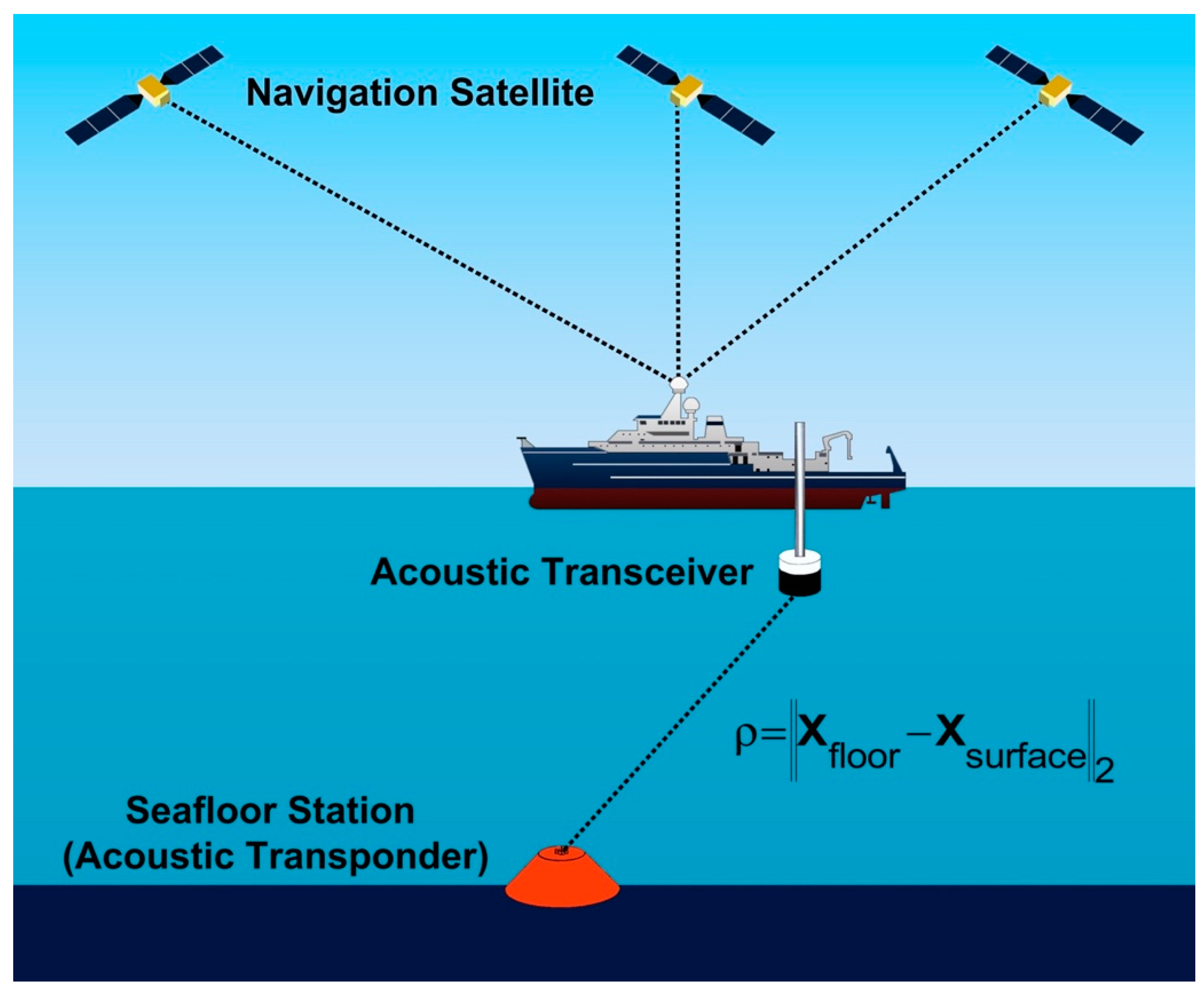
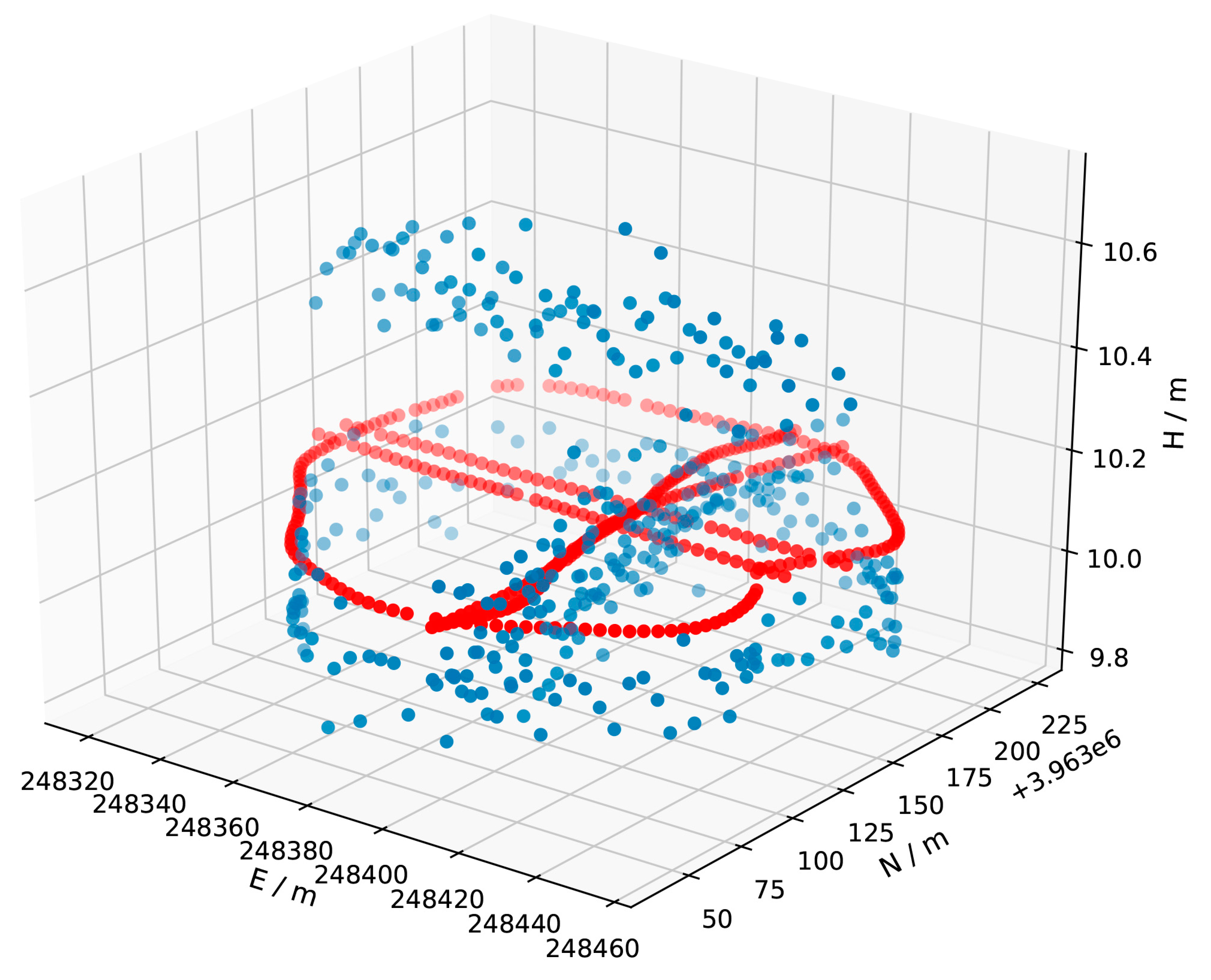
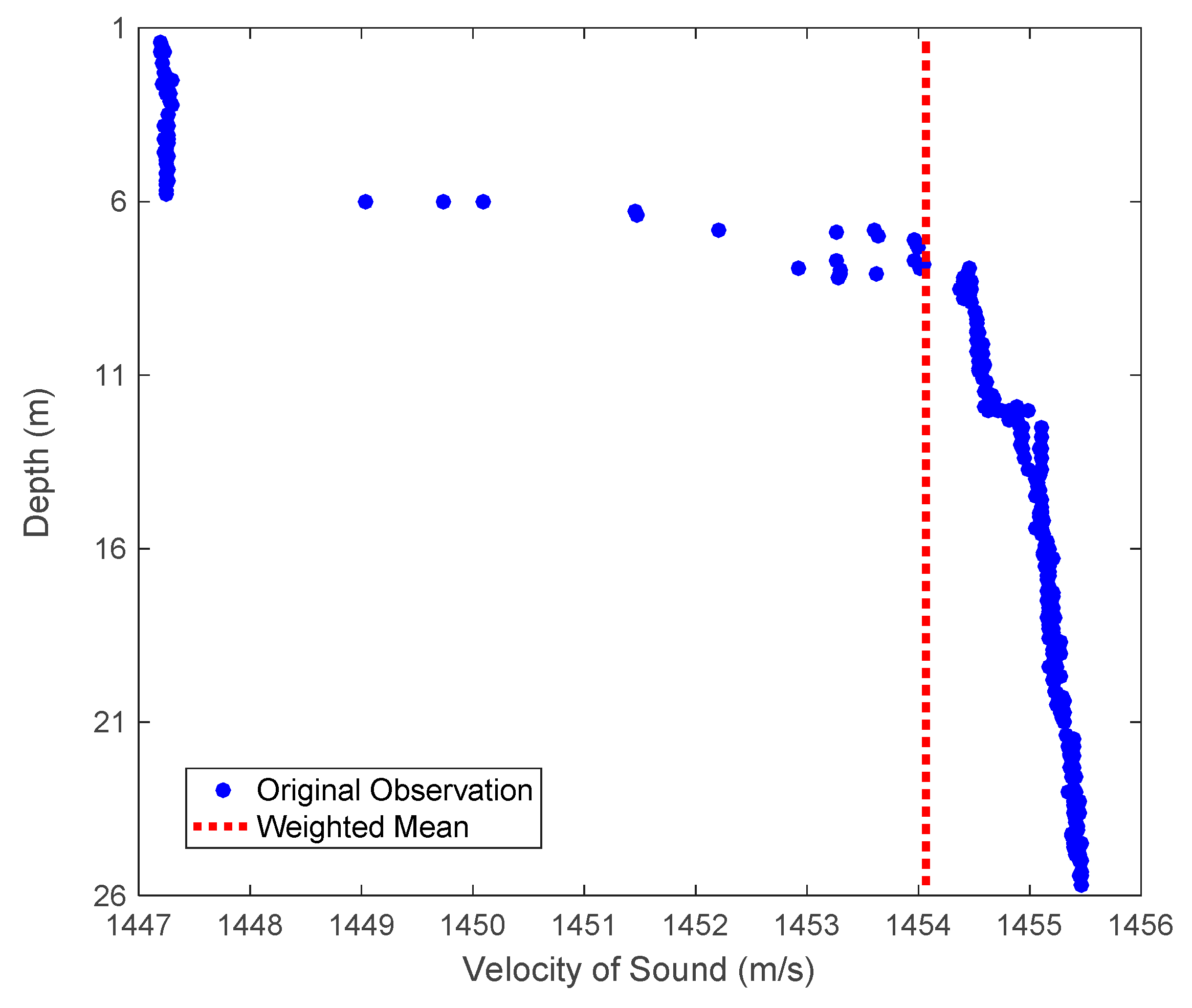
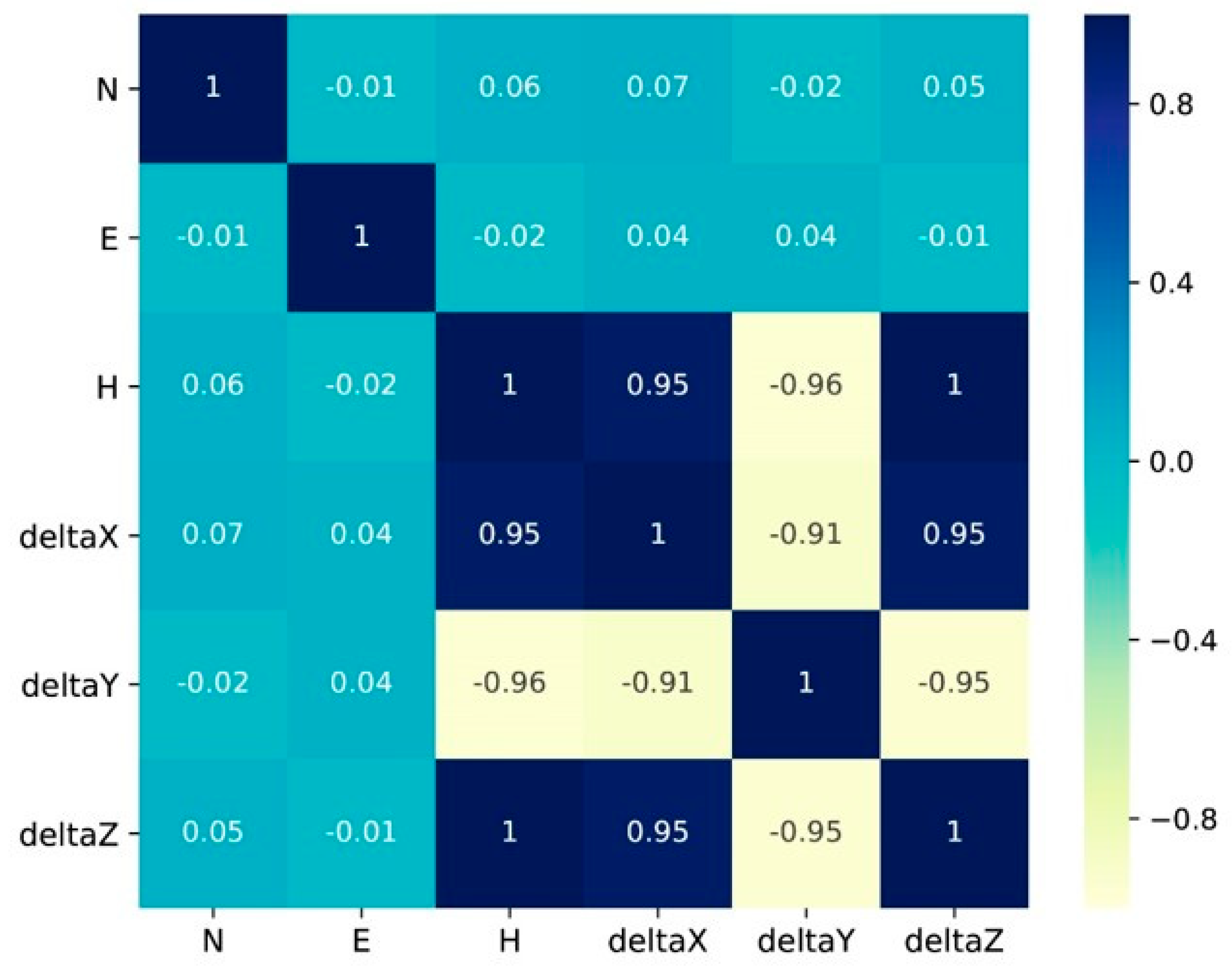
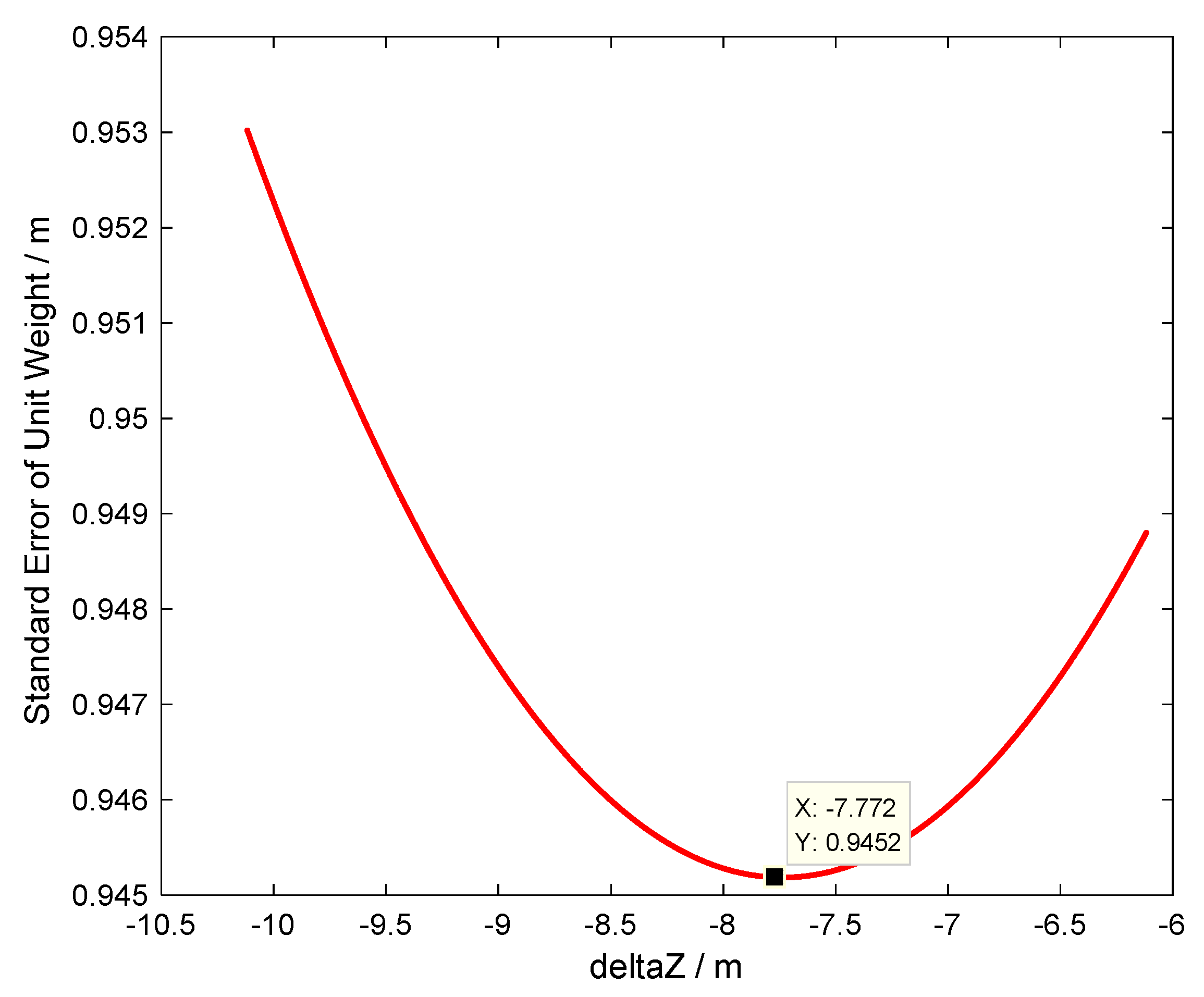
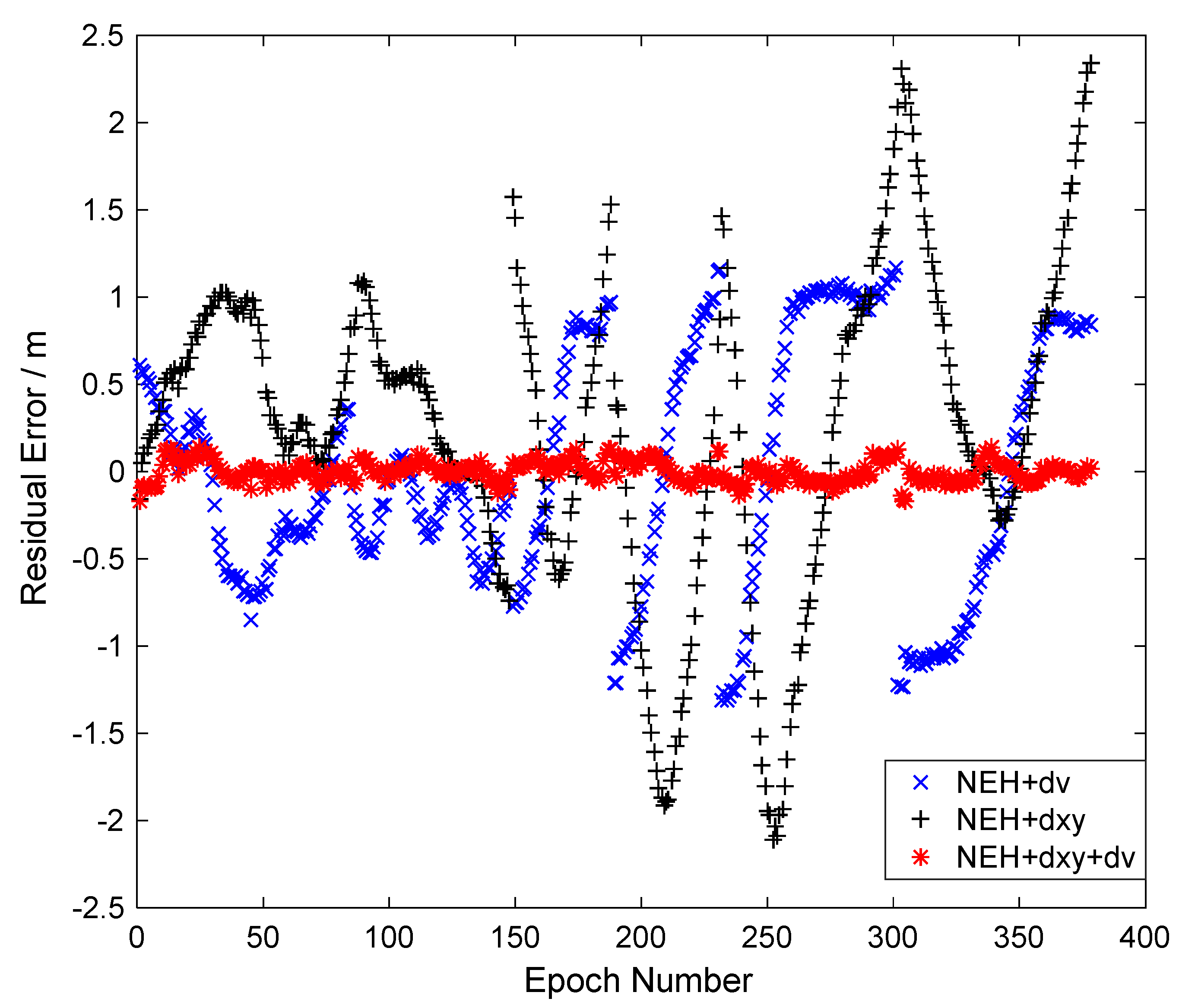
| Parameter Name | NEH Model | NEH+dxyz Model | NEH+dv Model | |||
|---|---|---|---|---|---|---|
| Estimate | STD | Estimate | STD | Estimate | STD | |
| N | 3963161.343 | 0.112 | 3963161.328 | 0.072 | 3963162.401 | 0.063 |
| E | 248380.512 | 0.136 | 248380.397 | 0.089 | 248380.164 | 0.068 |
| H | −14.902 | 0.242 | −20.961 | 4.453 | −17.868 | 0.134 |
| deltaX | - | - | 4.197 | 0.256 | - | - |
| deltaY | - | - | 3.179 | 0.259 | - | - |
| deltaZ | - | - | −13.504 | 4.436 | - | - |
| dvos | - | - | - | - | 43.014 | 1.245 |
| Parameter Name | Initial Value | NEH Model | NEH+dxy Model | ||
|---|---|---|---|---|---|
| Estimate | STD | Estimate | STD | ||
| N | 3963134.860 | 3963161.344 | 0.111 | 3963161.333 | 0.072 |
| E | 248394.141 | 248380.510 | 0.135 | 248380.397 | 0.089 |
| H | −19.246 | −14.430 | 0.238 | −15.212 | 0.159 |
| deltaX | 5.820 | - | - | 4.513 | 0.077 |
| deltaY | 1.706 | - | - | 2.860 | 0.077 |
| Parameter Name | NEH Model | NEH+dxy Model |
|---|---|---|
| Average | 0.488 | 0.267 |
| STD | 1.373 | 0.902 |
| Parameter Name | Initial Value | NEH+dv Model | NEH+dxy+dv Model | ||
|---|---|---|---|---|---|
| Estimate | STD | Estimate | STD | ||
| N | 3963134.860 | 3963162.390 | 0.062 | 3963162.240 | 0.005 |
| E | 248394.141 | 248380.165 | 0.067 | 248379.956 | 0.006 |
| H | −19.246 | −17.368 | 0.131 | −17.208 | 0.011 |
| deltaX | 5.820 | - | - | 4.688 | 0.005 |
| deltaY | 1.706 | - | - | 1.634 | 0.006 |
| dvos | 0.000 | 42.589 | 1.219 | 40.761 | 0.133 |
© 2019 by the authors. Licensee MDPI, Basel, Switzerland. This article is an open access article distributed under the terms and conditions of the Creative Commons Attribution (CC BY) license (http://creativecommons.org/licenses/by/4.0/).
Share and Cite
Chen, G.; Liu, Y.; Liu, Y.; Tian, Z.; Li, M. Adjustment of Transceiver Lever Arm Offset and Sound Speed Bias for GNSS-Acoustic Positioning. Remote Sens. 2019, 11, 1606. https://doi.org/10.3390/rs11131606
Chen G, Liu Y, Liu Y, Tian Z, Li M. Adjustment of Transceiver Lever Arm Offset and Sound Speed Bias for GNSS-Acoustic Positioning. Remote Sensing. 2019; 11(13):1606. https://doi.org/10.3390/rs11131606
Chicago/Turabian StyleChen, Guanxu, Yang Liu, Yanxiong Liu, Ziwen Tian, and Menghao Li. 2019. "Adjustment of Transceiver Lever Arm Offset and Sound Speed Bias for GNSS-Acoustic Positioning" Remote Sensing 11, no. 13: 1606. https://doi.org/10.3390/rs11131606
APA StyleChen, G., Liu, Y., Liu, Y., Tian, Z., & Li, M. (2019). Adjustment of Transceiver Lever Arm Offset and Sound Speed Bias for GNSS-Acoustic Positioning. Remote Sensing, 11(13), 1606. https://doi.org/10.3390/rs11131606





